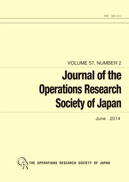All issues

Volume 51 (2008)
- Issue 4 Pages 265-
- Issue 3 Pages 203-
- Issue 2 Pages 127-
- Issue 1 Pages 1-
Volume 51, Issue 2
Displaying 1-10 of 10 articles from this issue
- |<
- <
- 1
- >
- >|
-
Article type: Cover
2008Volume 51Issue 2 Pages Cover4-
Published: 2008
Released on J-STAGE: June 27, 2017
JOURNAL FREE ACCESSDownload PDF (13K) -
Article type: Appendix
2008Volume 51Issue 2 Pages App3-
Published: 2008
Released on J-STAGE: June 27, 2017
JOURNAL FREE ACCESSDownload PDF (61K) -
Maiko ShigenoArticle type: Article
2008Volume 51Issue 2 Pages 127-135
Published: 2008
Released on J-STAGE: June 27, 2017
JOURNAL FREE ACCESSA robust approach to solving discrete optimization problems with uncertain data has recently been extensively studied and extended. This paper presents a new robust optimization model, called the adjustable robust optimization model, where a small perturbation for a solution is permitted after the uncertain parameters are realized. We apply this model to a 1-median location problem under uncertainty and give a polynomial time algorithm to determine robust solutions in the case of a tree graph.View full abstractDownload PDF (686K) -
Rashid Farooq, Yoshiko T Ikebe, Akihisa TamuraArticle type: Article
2008Volume 51Issue 2 Pages 136-154
Published: 2008
Released on J-STAGE: June 27, 2017
JOURNAL FREE ACCESSWe consider pairwise stability in a labor allocation model with possibly bounded salaries, which is a common generalization of the marriage model and the assignment model. Our main contributions are results on complexity of checking pairwise stability and structures of pairwise stable outcomes.View full abstractDownload PDF (1376K) -
Chin-Hsiung Wang, Chen-Chien HungArticle type: Article
2008Volume 51Issue 2 Pages 155-165
Published: 2008
Released on J-STAGE: June 27, 2017
JOURNAL FREE ACCESSTo solve the quality control problem for a batch produced from an unreliable production system, an economic offline inspection and disposition (ID) model was previously proposed where the process is assumed to have a constant failure rate, i.e., a geometric shift distribution. Through setting the proper value of parameters in the ID model, three commonly used policies: cost minimizing, perfect information and zero-defects are readily obtained. To facilitate the adoption of the developed ID model in practical applications, this study investigated the ID model in which two additional features are considered: (i) the process has a non-constant failure rate (NCFR). (ii) A manufacturing variation (MV) in the process exists. Two sets of recursive cost equations are obtained to establish an algorithm for the optimal ID policy of a given production lot. Numerical examples are used to show that MV and/or NCFR have significant effects on the minimum cost. The results also show that it is infeasible to reach the perfect information policy once MV exists, but that the zero-defects policy remains feasible. Finally, a concluding remark is made.View full abstractDownload PDF (771K) -
Yudai Honma, Osamu KuritaArticle type: Article
2008Volume 51Issue 2 Pages 166-190
Published: 2008
Released on J-STAGE: June 27, 2017
JOURNAL FREE ACCESSIn this paper, the optimal numbers of gas and hydrogen stations are examined. Recently, the possibility of gasoline vehicles being replaced with fuel cell vehicles (FCV) is being examined in the coming hydrogen society. The realization of this scenario however needs a large number of hydrogen refueling stations, which hardly exist at the present. We first calculate the optimal number of hydrogen stations to minimize the sum of two types of cost: 1) operation cost of hydrogen stations and 2) transportation cost of FCVs to the nearest stations. Next, we incorporate the diffusion rate of FCVs into the model to determine the optimal number of gas stations and that of hydrogen stations simultaneously. We also provide an advanced model that considers hybrid stations, with which both gasoline and FCVs can refuel. These models clarify that the optimal number of total stations varies with the diffusion rate of FCVs. If only gas and hydrogen stations are assumed, more stations are needed in the transition period. If hybrid stations are introduced, the number of total stations takes minimum value during the transition period. Moreover, the optimal solution indicates that all stations should become hybrid stations in the middle of the transition. Finally, the models are applied to Yokohama City in Japan and the solutions of the models are examined.View full abstractDownload PDF (1607K) -
Tomonari Kitahara, Shinji Mizuno, Kazuhide NakataArticle type: Article
2008Volume 51Issue 2 Pages 191-201
Published: 2008
Released on J-STAGE: June 27, 2017
JOURNAL FREE ACCESSWhen there are two classes whose mean vectors and covariance matrices are known, Lanckriet et al. [7] consider the Linear Minimax Classification (LMC) problem and they propose a method for solving it. In this paper we first discuss the Quadratic Minimax Classification (QMC) problem, which is a generalization of LMC. We show that QMC is transformed to a parametric Semidefinite Programming (SDP) problem. We further define the Convex Minimax Classification (CMC) problem. Though the two problems are generalizations of LMC, we prove that solutions of these problems can be obtained by solving LMC.View full abstractDownload PDF (723K) -
Article type: Appendix
2008Volume 51Issue 2 Pages App4-
Published: 2008
Released on J-STAGE: June 27, 2017
JOURNAL FREE ACCESSDownload PDF (93K) -
Article type: Cover
2008Volume 51Issue 2 Pages Cover5-
Published: 2008
Released on J-STAGE: June 27, 2017
JOURNAL FREE ACCESSDownload PDF (25K) -
Article type: Cover
2008Volume 51Issue 2 Pages Cover6-
Published: 2008
Released on J-STAGE: June 27, 2017
JOURNAL FREE ACCESSDownload PDF (25K)
- |<
- <
- 1
- >
- >|